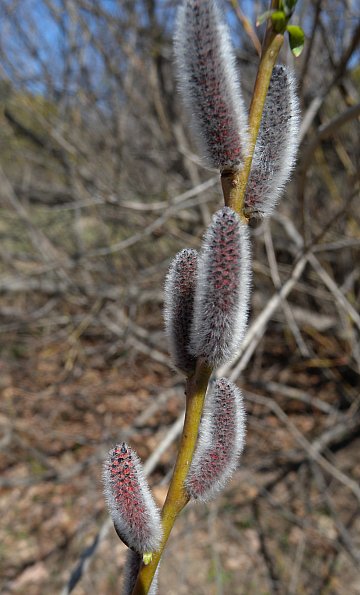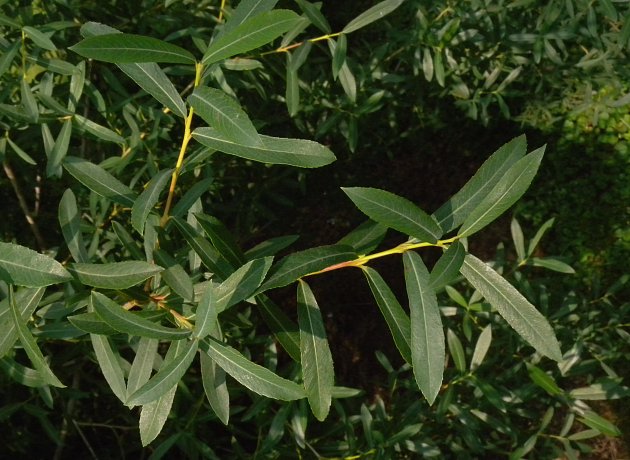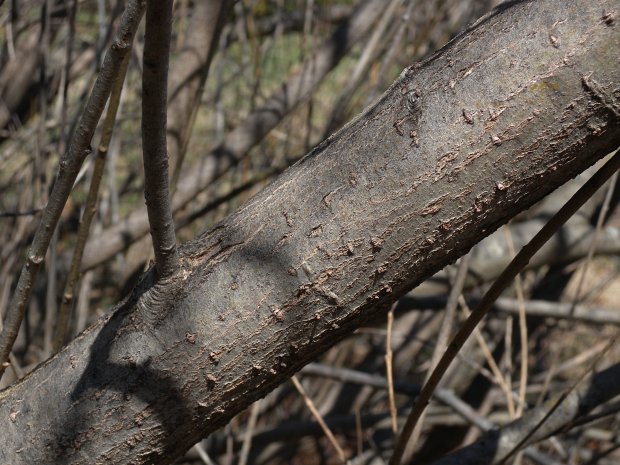
Female catkins are ¾–1½" long at maturity; when they are immature, they are green or greenish yellow. Each female catkin is cylindrical in shape, consisting of several female florets along all sides of a central stalk. The ovaries of the female florets are short-lanceoloid in shape, short-pubescent, and sessile or nearly so. At the apex of each ovary, there is a very short style that divides into 2 stigmas. Like the male florets, the female florets have small bracts at their bases. The blooming period occurs during mid-spring for about 1-2 weeks; the florets are cross-pollinated primarily by insects and to a lesser extent by the wind. Afterwards, the female florets are replaced by small seed capsules that are about 3-5 mm. long. These seed capsules turn brown and split open to release their seeds during early summer. The tiny seeds are covered in cottony tufts of hair, and they are distributed to some extent by the wind (and possibly water). The root system is woody, shallow, and branching. This willow spreads primarily by layering (twigs and branches that lie along the ground, eventually forming new roots) and arching (twigs that arch, their tips touching the ground and forming new roots). In this manner, clonal offshoots are created. Twigs can also break off at their bases and become lodged in the ground, forming clonal offshoots. This willow has a tendency to form dense clonal colonies.
Cultivation: The preference is full or partial sun, wet to moist conditions, and soil containing silt-loam. However, drier conditions and soil containing sand or stony material are also tolerated. This willow develops rapidly and it has a tendency to spread. The seeds remain viable for only 2 weeks and require moist ground to germinate. However, the easiest method of propagation involves cutting the twigs during early spring and sticking them into the ground, where they readily form new roots. Relatively cool and moist weather is preferred, although episodes of hot weather are tolerated if they don't last too long. This willow remains winter-hardy to Zone 3.

Range & Habitat: In Illinois, naturalized populations of Purple Osier are restricted to NE Illinois (see Distribution Map), where it is rare. In North America, naturalized populations of this willow are found primarily in NE USA, SE Canada, and around the Great Lakes. It was introduced from Eurasia primarily to reduce erosion along stream banks and lake shores. Habitats include ditches, low ground along streams and lakes, low depressions between sand dunes, alder thickets, fens, and swamps. In Illinois, Purple Osier is found primarily in disturbed areas, although it has the potential to invade higher quality natural areas. Occasionally, this willow is cultivated for its attractive twigs, foliage, and purplish male catkins.
Faunal Associations: Little is known specifically about this willow's interrelationships with insects, but it is probably similar to other willows. The florets of willows are cross-pollinated primarily by bees and flies, including honeybees, cuckoo bees (Nomada spp.), mason bees (Osmia spp.), Halictid bees, Andrenid bees (Andrena spp.), Syrphid flies, dance flies (Empididae), thick-headed flies (Conopidae), Tachinid flies, Muscid flies, and other insects. Many kinds of insects feed on the wood, foliage, and other parts of willows. These species include larvae of metallic wood-boring bees (Buprestidae), larvae of long-horned beetles (Cerambycidae), adults and larvae of leaf beetles (Chrysomelidae), adults and larvae of weevils (Curculionidae), larvae of leaf-miner flies (Agromyzidae), larvae of gall flies (Cecidomyzidae), plant bugs (Miridae), stink bugs (Pentatomidae), aphids (Aphididae), spittlebugs (Cercopidae), leafhoppers (Cicadellidae), armored scale insects (Diaspididae), sawflies (Argidae, Cimbicidae, Tenthredinidae), larvae of moths (many different families), larvae of butterflies (Lycaenidae, Nymphalidae), and thrips (Thripidae). Among vertebrate animals, White-tailed Deer browse on the twigs and foliage, while beavers eat the branches and twigs; beavers also use the branches and twigs in the construction of their dams and lodges. Because Purple Osier is a densely branched and bushy shrub, it provides good cover for many kinds of wildlife and nesting habitat for several songbirds.

Photographic Location: The Arboretum of the University of Illinois in Urbana, Illinois.
Comments: Purple Osier (Salix purpurea) is one of many wild willows (Salix spp.) that occur in Illinois. Because of some distinctive characteristics, it is one of the easier willows to identify within the state. Purple-Osier differs from many other willows by the following characteristics: 1) its male catkins are tinted reddish purple while they are immature, 2) each male floret has 2 anthers that share a single filament, 3) the ovaries of its female florets are sessile or nearly so, and 4) its leaves are often opposite or nearly so, especially toward the tips of its young shoots. While the twigs of this willow are often purple, this is not a reliable characteristic because they can also be greenish yellow, brown, and other colors. Similarly, the leaves are sometimes blue-green or tinted with purple, but sometimes they are plain green. Commercial nurseries sell several cultivars of this willow that can vary in the size of the shrub, color of foliage, and color of twigs. Other common names of this willow include Purple Willow and Basket Willow. The latter common name is derived from the fact that the twigs of this willow are quite flexible, allowing them to be used in the construction of baskets and other hand-crafted items. The word 'osier' refers to any willow with flexible stems that has been used to make such items.